Abstract
Heat-stable enterotoxins (STs) from four strains of bovine enterotoxigenic Escherichia coli representing four serogroups were purified to homogeneity by utilizing previously published purification schemata. Biochemical characterization of the purified STs showed that they met the basic criteria for the heat-stable enterotoxins of E. coli. Amino acid analysis of the purified STs revealed that they were peptides of identical amino acid composition. This composition consisted of 18 residues of 10 different amino acids, 6 of which were cysteine. The amino acid composition of the four ST peptides was identical to that reported for the STs of human and porcine E. coli. In addition, complete sequence analysis of two of the ST peptides and partial sequencing of several others revealed strong homology to the sequences of STs from human and porcine E. coli and to the sequence predicted from the last 18 codons of the transposon Tn1681. There was also substantial homology to the sequence predicted from the ST-coding genetic element of human E. coli, which may indicate the existence of identical bioactive configuration among ST peptides of E. coli strains of various host origins. These data support the hypothesis that STs produced by human, bovine, and porcine E. coli are coded by a closely related genetic element which may have originated from a single, widely disseminated transposon.
Full text
PDF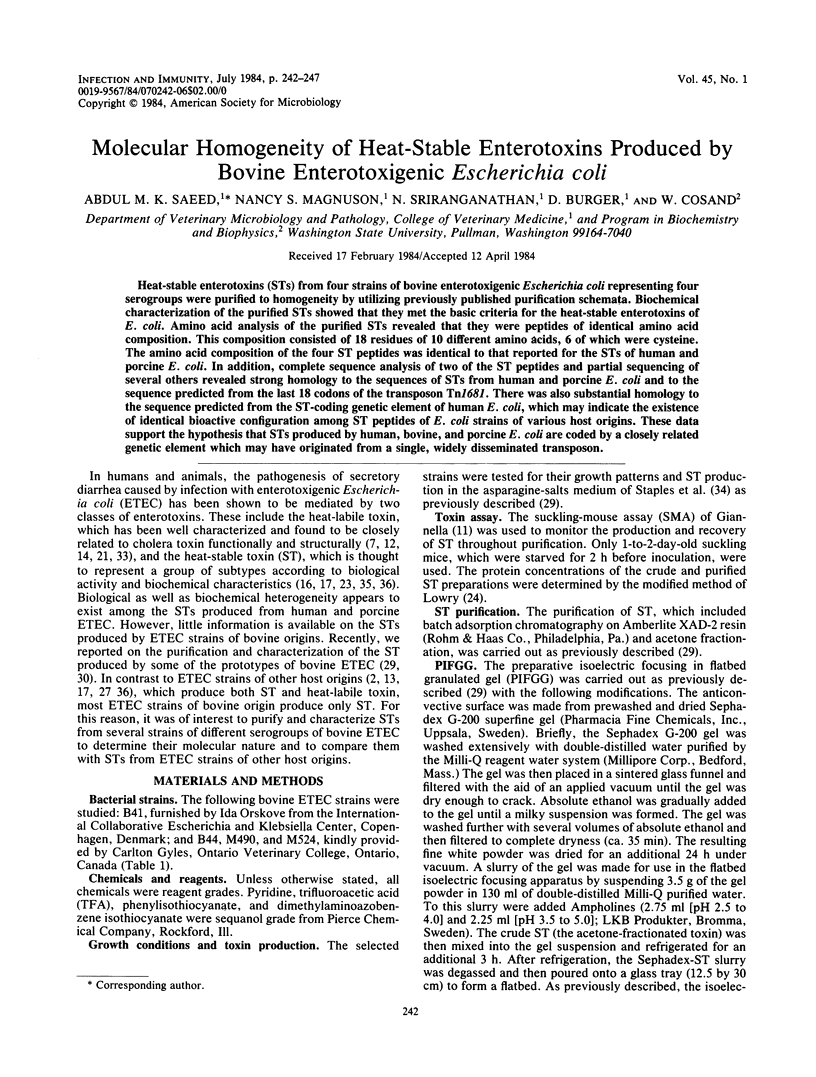
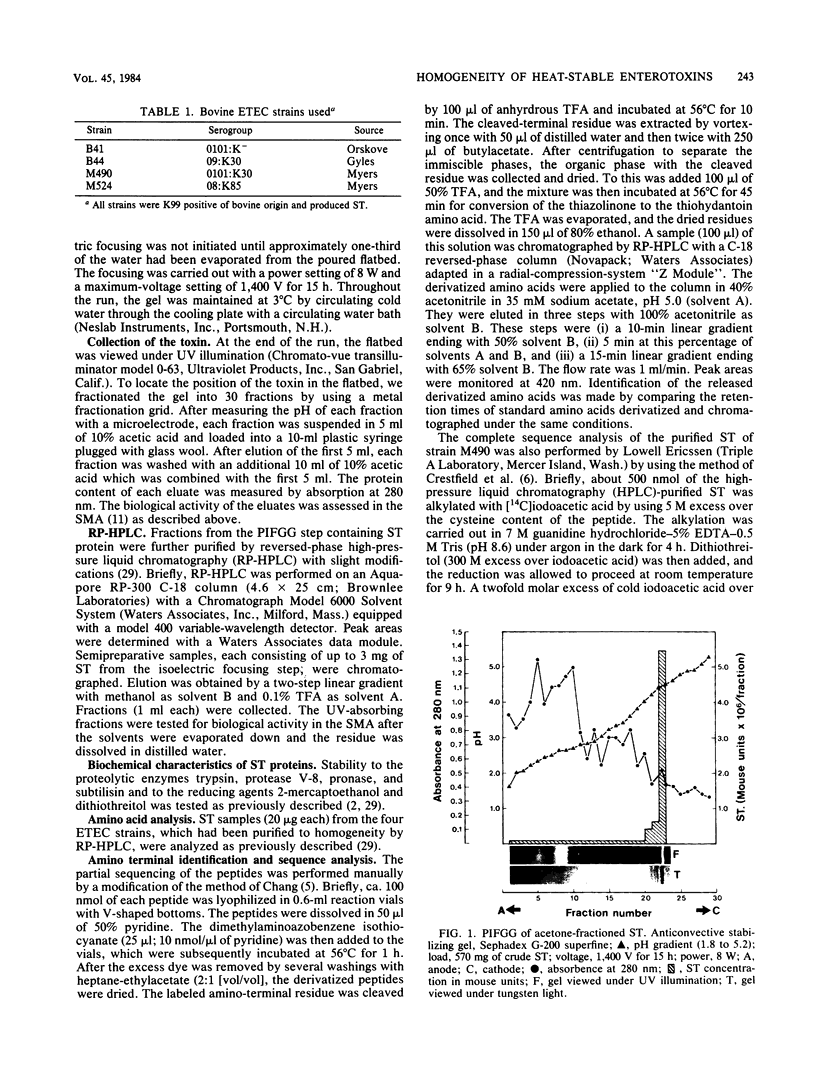
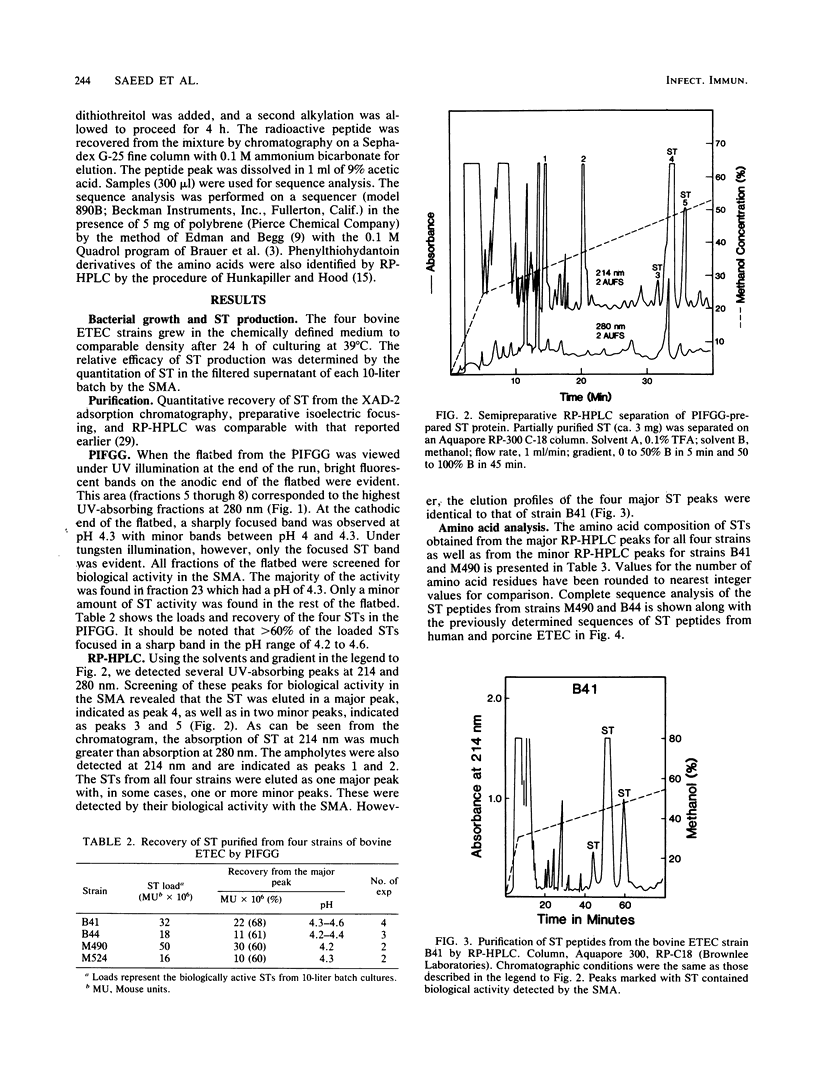
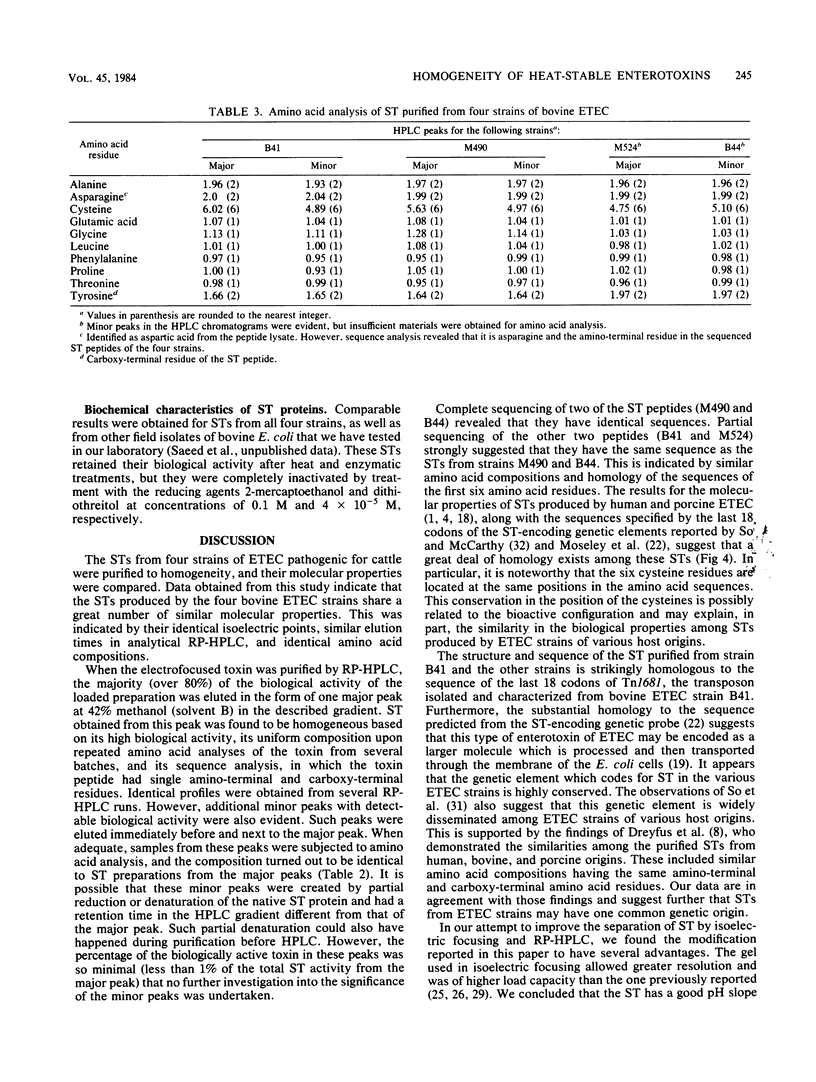
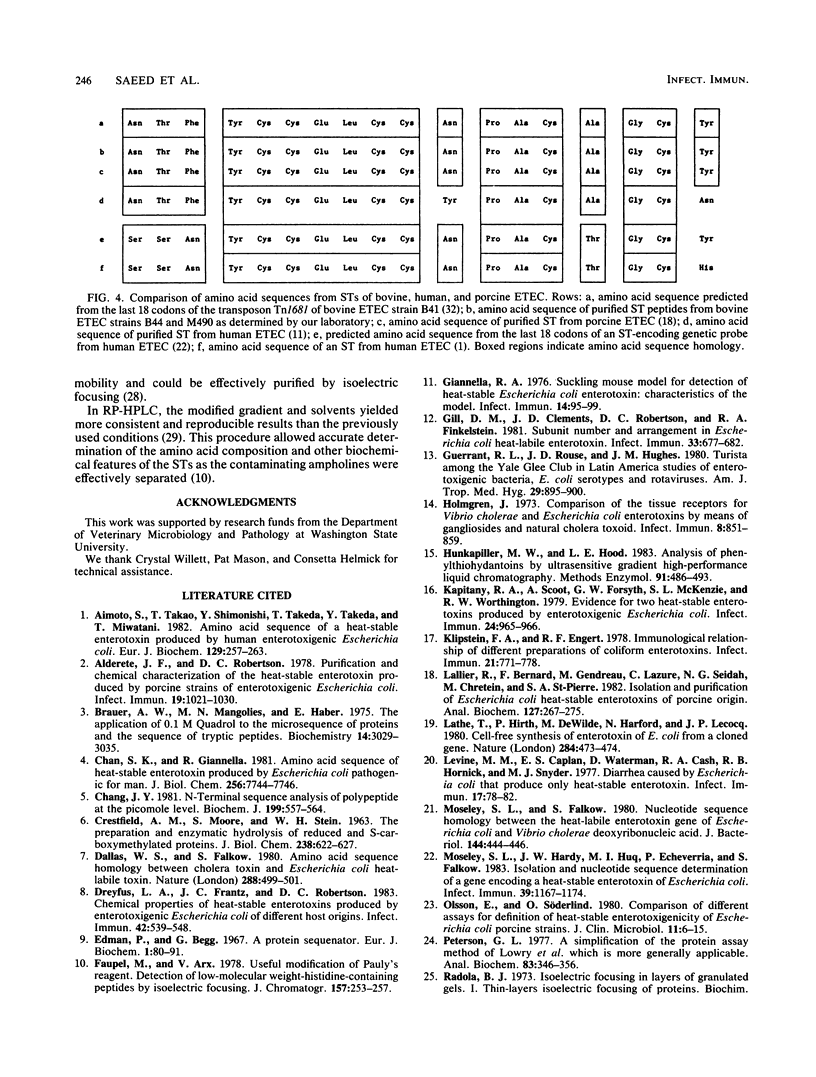
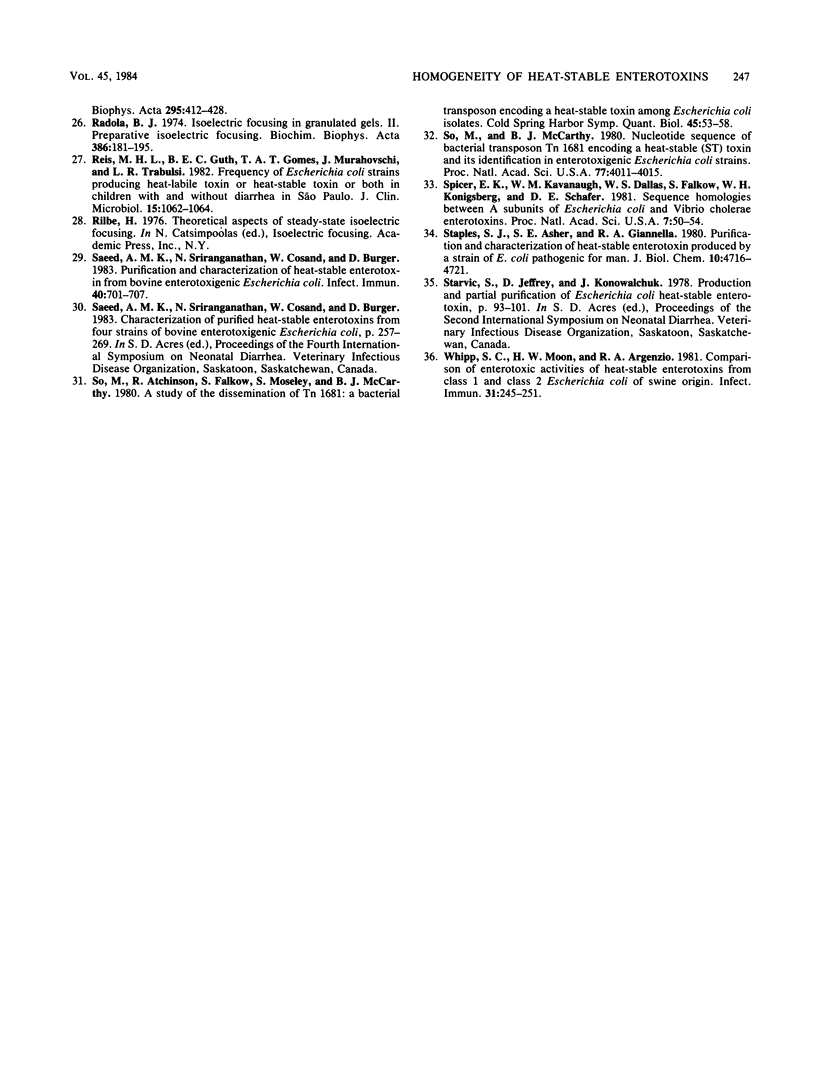
Images in this article
Selected References
These references are in PubMed. This may not be the complete list of references from this article.
- Aimoto S., Takao T., Shimonishi Y., Hara S., Takeda T., Takeda Y., Miwatani T. Amino-acid sequence of a heat-stable enterotoxin produced by human enterotoxigenic Escherichia coli. Eur J Biochem. 1982 Dec 15;129(2):257–263. doi: 10.1111/j.1432-1033.1982.tb07047.x. [DOI] [PubMed] [Google Scholar]
- Alderete J. F., Robertson D. C. Purification and chemical characterization of the heat-stable enterotoxin produced by porcine strains of enterotoxigenic Escherichia coli. Infect Immun. 1978 Mar;19(3):1021–1030. doi: 10.1128/iai.19.3.1021-1030.1978. [DOI] [PMC free article] [PubMed] [Google Scholar]
- Brauer A. W., Margolies M. N., Haber E. The application of 0.1 M quadrol to the microsequence of proteins and the sequence of tryptic peptides. Biochemistry. 1975 Jul;14(13):3029–3035. doi: 10.1021/bi00684a036. [DOI] [PubMed] [Google Scholar]
- CRESTFIELD A. M., MOORE S., STEIN W. H. The preparation and enzymatic hydrolysis of reduced and S-carboxymethylated proteins. J Biol Chem. 1963 Feb;238:622–627. [PubMed] [Google Scholar]
- Chan S. K., Giannella R. A. Amino acid sequence of heat-stable enterotoxin produced by Escherichia coli pathogenic for man. J Biol Chem. 1981 Aug 10;256(15):7744–7746. [PubMed] [Google Scholar]
- Chang J. Y. N-terminal sequence analysis of polypeptide at the picomole level. Biochem J. 1981 Dec 1;199(3):557–564. doi: 10.1042/bj1990557. [DOI] [PMC free article] [PubMed] [Google Scholar]
- Dallas W. S., Falkow S. Amino acid sequence homology between cholera toxin and Escherichia coli heat-labile toxin. Nature. 1980 Dec 4;288(5790):499–501. doi: 10.1038/288499a0. [DOI] [PubMed] [Google Scholar]
- Dreyfus L. A., Frantz J. C., Robertson D. C. Chemical properties of heat-stable enterotoxins produced by enterotoxigenic Escherichia coli of different host origins. Infect Immun. 1983 Nov;42(2):539–548. doi: 10.1128/iai.42.2.539-548.1983. [DOI] [PMC free article] [PubMed] [Google Scholar]
- Edman P., Begg G. A protein sequenator. Eur J Biochem. 1967 Mar;1(1):80–91. doi: 10.1007/978-3-662-25813-2_14. [DOI] [PubMed] [Google Scholar]
- Giannella R. A. Suckling mouse model for detection of heat-stable Escherichia coli enterotoxin: characteristics of the model. Infect Immun. 1976 Jul;14(1):95–99. doi: 10.1128/iai.14.1.95-99.1976. [DOI] [PMC free article] [PubMed] [Google Scholar]
- Gill D. M., Clements J. D., Robertson D. C., Finkelstein R. A. Subunit number and arrangement in Escherichia coli heat-labile enterotoxin. Infect Immun. 1981 Sep;33(3):677–682. doi: 10.1128/iai.33.3.677-682.1981. [DOI] [PMC free article] [PubMed] [Google Scholar]
- Guerrant R. L., Rouse J. D., Hughes J. M., Rowe B. Turista among members of the Yale Glee Club in Latin America. Am J Trop Med Hyg. 1980 Sep;29(5):895–900. doi: 10.4269/ajtmh.1980.29.895. [DOI] [PubMed] [Google Scholar]
- Holmgren J. Comparison of the tissue receptors for Vibrio cholerae and Escherichia coli enterotoxins by means of gangliosides and natural cholera toxoid. Infect Immun. 1973 Dec;8(6):851–859. doi: 10.1128/iai.8.6.851-859.1973. [DOI] [PMC free article] [PubMed] [Google Scholar]
- Hunkapiller M. W., Hood L. E. Analysis of phenylthiohydantoins by ultrasensitive gradient high-performance liquid chromatography. Methods Enzymol. 1983;91:486–493. doi: 10.1016/s0076-6879(83)91045-5. [DOI] [PubMed] [Google Scholar]
- Kapitany R. A., Scoot A., Forsyth G. W., McKenzie S. L., Worthington R. W. Evidence for two heat-stable enterotoxins produced by enterotoxigenic Escherichia coli. Infect Immun. 1979 Jun;24(3):965–966. doi: 10.1128/iai.24.3.965-966.1979. [DOI] [PMC free article] [PubMed] [Google Scholar]
- Klipstein F. A., Engert R. F. Immunological relationship of different preparations of coliform enterotoxins. Infect Immun. 1978 Sep;21(3):771–778. doi: 10.1128/iai.21.3.771-778.1978. [DOI] [PMC free article] [PubMed] [Google Scholar]
- Lallier R., Bernard F., Gendreau M., Lazure C., Seidah N. G., Chrétien M., St-Pierre S. A. Isolation and purification of Escherichia coli heat-stable enterotoxin of porcine origin. Anal Biochem. 1982 Dec;127(2):267–275. doi: 10.1016/0003-2697(82)90171-3. [DOI] [PubMed] [Google Scholar]
- Lathe R., Hirth P., DeWilde M., Harford N., Lecocq J. P. Cell-free synthesis of enterotoxin of E. coli from a cloned gene. Nature. 1980 Apr 3;284(5755):473–474. doi: 10.1038/284473a0. [DOI] [PubMed] [Google Scholar]
- Levine M. M., Caplan E. S., Waterman D., Cash R. A., Hornick R. B., Snyder M. J. Diarrhea caused by Escherichia coli that produce only heat-stable enterotoxin. Infect Immun. 1977 Jul;17(1):78–82. doi: 10.1128/iai.17.1.78-82.1977. [DOI] [PMC free article] [PubMed] [Google Scholar]
- Moseley S. L., Falkow S. Nucleotide sequence homology between the heat-labile enterotoxin gene of Escherichia coli and Vibrio cholerae deoxyribonucleic acid. J Bacteriol. 1980 Oct;144(1):444–446. doi: 10.1128/jb.144.1.444-446.1980. [DOI] [PMC free article] [PubMed] [Google Scholar]
- Moseley S. L., Hardy J. W., Hug M. I., Echeverria P., Falkow S. Isolation and nucleotide sequence determination of a gene encoding a heat-stable enterotoxin of Escherichia coli. Infect Immun. 1983 Mar;39(3):1167–1174. doi: 10.1128/iai.39.3.1167-1174.1983. [DOI] [PMC free article] [PubMed] [Google Scholar]
- Olsson E., Söderlind O. Comparison of different assays for definition of heat-stable enterotoxigenicity of Escherichia coli porcine strains. J Clin Microbiol. 1980 Jan;11(1):6–15. doi: 10.1128/jcm.11.1.6-15.1980. [DOI] [PMC free article] [PubMed] [Google Scholar]
- Peterson G. L. A simplification of the protein assay method of Lowry et al. which is more generally applicable. Anal Biochem. 1977 Dec;83(2):346–356. doi: 10.1016/0003-2697(77)90043-4. [DOI] [PubMed] [Google Scholar]
- Radola B. J. Isoelectric focusing in layers of granulated gels. II. Preparative isoelectric focusing. Biochim Biophys Acta. 1975 Mar 28;386(1):181–195. doi: 10.1016/0005-2795(75)90258-5. [DOI] [PubMed] [Google Scholar]
- Reis M. H., Guth B. E., Gomes T. A., Murahovschi J., Trabulsi L. R. Frequency of Escherichia coli strains producing heat-labile toxin or heat-stable toxin or both in children with and without diarrhea in São Paulo. J Clin Microbiol. 1982 Jun;15(6):1062–1064. doi: 10.1128/jcm.15.6.1062-1064.1982. [DOI] [PMC free article] [PubMed] [Google Scholar]
- Saeed A. M., Sriranganathan N., Cosand W., Burger D. Purification and characterization of heat-stable enterotoxin from bovine enterotoxigenic Escherichia coli. Infect Immun. 1983 May;40(2):701–707. doi: 10.1128/iai.40.2.701-707.1983. [DOI] [PMC free article] [PubMed] [Google Scholar]
- So M., Atchison R., Falkow S., Moseley S., McCarthy B. J. A study of the dissemination of Tn1681: a bacterial transposon encoding a heat-stable toxin among enterotoxigenic Escherichia coli isolates. Cold Spring Harb Symp Quant Biol. 1981;45(Pt 1):53–58. doi: 10.1101/sqb.1981.045.01.010. [DOI] [PubMed] [Google Scholar]
- So M., McCarthy B. J. Nucleotide sequence of the bacterial transposon Tn1681 encoding a heat-stable (ST) toxin and its identification in enterotoxigenic Escherichia coli strains. Proc Natl Acad Sci U S A. 1980 Jul;77(7):4011–4015. doi: 10.1073/pnas.77.7.4011. [DOI] [PMC free article] [PubMed] [Google Scholar]
- Spicer E. K., Kavanaugh W. M., Dallas W. S., Falkow S., Konigsberg W. H., Schafer D. E. Sequence homologies between A subunits of Escherichia coli and Vibrio cholerae enterotoxins. Proc Natl Acad Sci U S A. 1981 Jan;78(1):50–54. doi: 10.1073/pnas.78.1.50. [DOI] [PMC free article] [PubMed] [Google Scholar]
- Staples S. J., Asher S. E., Giannella R. A. Purification and characterization of heat-stable enterotoxin produced by a strain of E. coli pathogenic for man. J Biol Chem. 1980 May 25;255(10):4716–4721. [PubMed] [Google Scholar]
- Whipp S. C., Moon H. W., Argenzio R. A. Comparison of enterotoxic activities of heat-stable enterotoxins from class 1 and class 2 Escherichia coli of swine origin. Infect Immun. 1981 Jan;31(1):245–251. doi: 10.1128/iai.31.1.245-251.1981. [DOI] [PMC free article] [PubMed] [Google Scholar]



